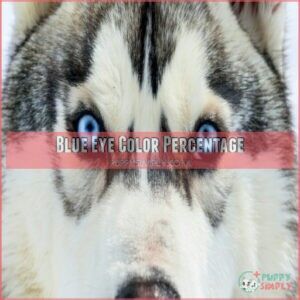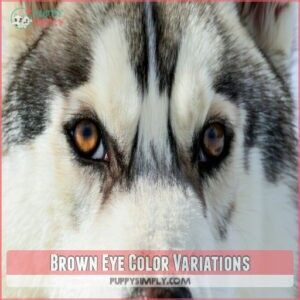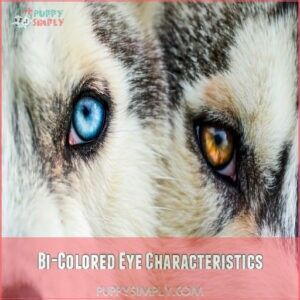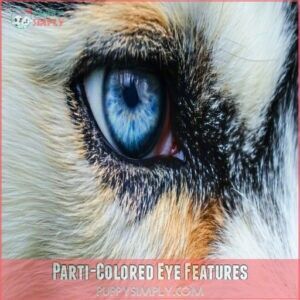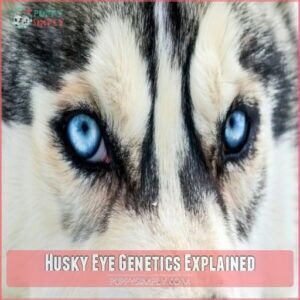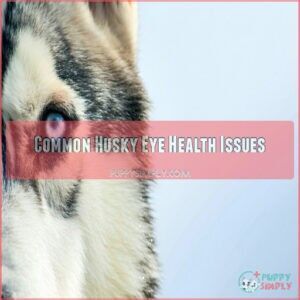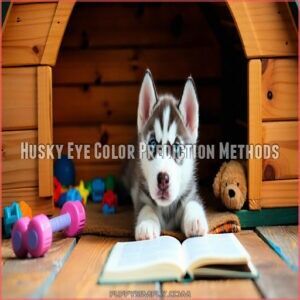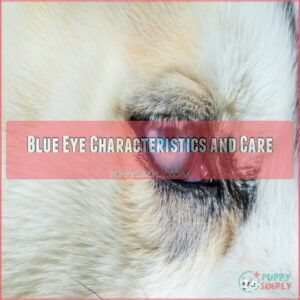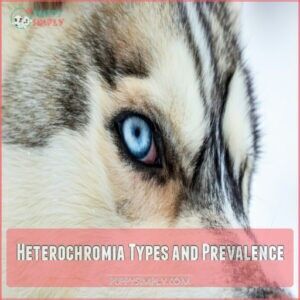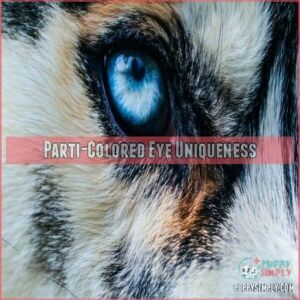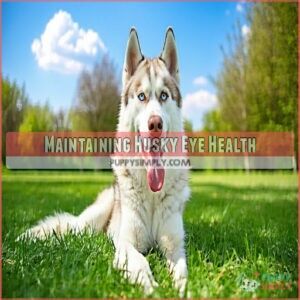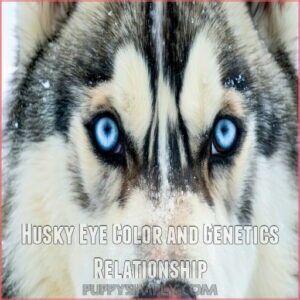This site is supported by our readers. We may earn a commission, at no cost to you, if you purchase through links.
 Husky eye color is nothing short of magical! These striking dogs can have piercing blue eyes (around 40% of them), warm brown eyes, or unique combinations like bi-colored (each eye different) or parti-colored (two colors in one eye).
Husky eye color is nothing short of magical! These striking dogs can have piercing blue eyes (around 40% of them), warm brown eyes, or unique combinations like bi-colored (each eye different) or parti-colored (two colors in one eye).
Some even have heterochromia—when their eyes are two completely different shades! All Husky puppies start with blue eyes, but their true eye color usually settles by 12-16 weeks, though it can take up to 6 months.
Genetics, especially the ALX4 gene, plays a huge role in their eye color. With such dazzling eyes, keeping them healthy is important—regular vet checkups are key!
Table Of Contents
- Key Takeaways
- Husky Eye Color Variations
- Husky Eye Development Stages
- Husky Eye Genetics Explained
- Common Husky Eye Health Issues
- Husky Eye Color Prediction Methods
- Unique Husky Eye Color Features
- Maintaining Husky Eye Health
- Husky Eye Color and Genetics Relationship
- Frequently Asked Questions (FAQs)
- What is the rarest eye color for a husky?
- When can you tell husky eye color?
- What does it mean when a husky has two different colored eyes?
- What color are a Shepsky’s eyes?
- Can diet or supplements affect the eye color of a Husky?
- Do Husky eye colors fade with age?
- What do pale Husky eyes indicate?
- Can Husky eyes be affected by diet?
- Are red or pink Husky eyes normal?
- How to protect Husky eyes from sunlight?
- Conclusion
Key Takeaways
- Husky eye colors can range from piercing blue and warm brown to unique combinations like bi-colored (each eye a different color) or parti-colored (two colors in one eye), with genetics like the ALX4 gene playing a significant role.
- All Husky puppies start with blue eyes, but their final eye color usually settles between 12-16 weeks, sometimes taking up to 6 months.
- Unique traits like heterochromia (two completely different eye colors) or parti-colored eyes result from varying melanin levels and don’t affect vision.
- Regular vet check-ups, good nutrition, and proper eye care are essential to keep your Husky’s striking eyes healthy and free from issues like corneal dystrophy or juvenile cataracts.
Husky Eye Color Variations
You’re about to explore the fascinating world of husky eye colors, where you’ll discover the unique characteristics of blue, brown, bi-colored, and parti-colored eyes.
As you learn more about husky eye color variations, you’ll find out what makes each type special and how they’re determined by genetics.
Blue Eye Color Percentage
You’ll find blue eyes in about 40% of Huskies, thanks to Blue Eye Genetics.
This Eye Color Stat is notable, as Husky Vision is unique.
The blue iris is a stunning Eye Shade Variation, making husky blue eyes a beloved trait, especially in bi-eyed huskies, though heterochromia husky cases exist.
Understanding Husky Eye Colors can help owners appreciate their dog’s unique features, including Husky Vision and bi-eyed huskies.
Brown Eye Color Variations
You’ll notice husky brown eyes have varying brown shades due to eye pigmentation, with differences in color intensity and hue variance, making each dog unique.
The unique appearance of their eyes showcases tone differences in their brown eyes, a result of dog eye color genetics and husky eye color variations.
Bi-Colored Eye Characteristics
You’re looking at a bieyed husky with unique Eye Color Patterns.
- Iris Pigmentation varies
- Pupil Shape differs
- Eye Shade Variance occurs
- Color Distribution is distinct, showcasing heterochromia and bicolored eyes.
Parti-Colored Eye Features
You’re exploring parti-colored eye features in Huskies, a unique trait with two distinct colors in one iris, like a bieyed husky or parti eye color husky, showcasing heterochromia and different husky eye colors.
Understanding husky eye colors is essential to appreciate the genetics behind these unique traits, with eye pigmentation and color patterns making each iris shape and eye expression special.
Husky Eye Development Stages
You’re probably wondering how your husky’s eye color develops, and it’s actually pretty fascinating.
As you watch your puppy grow, their eye color can change dramatically, and understanding the different stages they go through, from birth to adulthood, is key.
This process is a natural part of their development, and recognizing the different stages can help you better understand your husky’s growth.
Puppy Eye Color Change
You witness a color shift in husky puppy eye color as eye pigmentation develops.
Iris development occurs, changing their pup eye care needs.
Understanding do husky eyes change color helps with dog eye color change and husky eye color genetics, ensuring proper husky puppy eye color care.
Eye Color Transition Timeline
Your husky’s eye color journey starts at birth with those adorable baby blues.
By week 5-8, you’ll start seeing the first hints of their permanent color taking shape.
While most pups settle into their final eye color between 12-16 weeks, some can keep you guessing for up to 6 months.
Keep tabs on these changes – they’re part of your pup’s unique development story.
Factors Influencing Eye Color
The striking variety of husky eye color depends on several fascinating factors working together.
Your pup’s genetic makeup, particularly the ALX4 gene and melanin distribution, plays the starring role.
High melanin levels typically result in brown eyes, while lower concentrations create those iconic blue peepers.
Environmental factors and inheritance patterns from both parents influence the final eye color, with some huskies even developing unique parti-colored or heterochromatic patterns.
Husky Eye Genetics Explained
You’re about to learn how the genetics of husky eye color work, and it’s pretty fascinating.
By understanding the role of genes like ALX4, you’ll get a better sense of what determines those beautiful blue, brown, or bi-colored eyes in huskies.
ALX4 Gene and Blue Eyes
You’ll find the ALX4 gene controls blue eyes in huskies, affecting eye pigmentation through genetic coding and allele variants, resulting in a blue iris due to reduced pigment production, a key aspect of husky eye color determined by the ALX4 gene expression.
The genetics of dog eye color, including blue eye genetics, play a pivotal role in understanding the unique characteristics of various breeds, particularly those with blue eyes.
Heterochromia Causes and Effects
So, you’ve heard about the ALX4 gene’s role in those captivating blue peepers.
Now, let’s chat about another unique eye trait in Huskies: heterochromia.
This is when a Husky’s eyes showcase different colors or even multiple colors within the same iris.
It’s nature’s way of mixing things up!
Heterochromia and Its Effects
- It’s nature’s fun twist, creating a unique, fascinating look.
- Results from varying levels of melanin in different parts of the iris.
- May be complete (one color in one iris, another color in the other) or sectoral (multiple colors in one or both irises).
- Can develop at any age, even in adulthood.
- Doesn’t impact vision; it’s purely an eye-catching feature.
Genetic Basis of Eye Color
The unique eye colors of Huskies are determined by their genetic coding. It’s all about eye pigmentation and gene expression. DNA testing reveals that specific inheritance patterns influence eye color, with certain genes playing a dominant or recessive role. The HERC2 gene, for instance, affects melanin production, resulting in blue or brown eyes.
Gene Eye Color Expression
Common Husky Eye Health Issues
You’re likely wondering what common eye health issues your husky might face, and it’s great that you’re taking proactive steps to learn more.
As you learn about husky eye health, you’ll discover that conditions like corneal dystrophy, juvenile cataracts, and progressive retinal atrophy can affect your dog’s vision and overall well-being.
Corneal Dystrophy Symptoms
You’re now concerned about corneal dystrophy, a husky eye problem.
Corneal damage causes eye discomfort, vision loss, and a cloudy cornea, often with eye inflammation, affecting husky eye health and potentially leading to dog eye diseases, making regular check-ups essential to prevent or manage corneal dystrophy symptoms.
Effective corneal dystrophy treatment options are available to address these issues, which is crucial for maintaining good eye health.
Juvenile Cataracts Risk Factors
For Huskies, juvenile cataracts can develop due to genetic predisposition, improper nutrition impact, or even an eye injury during puppyhood.
Environmental factors like UV exposure might also add to the risk.
With husky eye problems, it’s vital to monitor for signs early since cataracts can lead to vision loss.
Protect those husky health eyes—regular check-ups are your best bet!
Progressive Retinal Atrophy Prevention
Progressive retinal atrophy in huskies can’t be cured, but you can take steps to maintain retinal health and overall husky eye care.
Here’s how:
- Genetic Testing: Screen breeding pairs to prevent passing on PRA genes.
- Diet Management and Eye Supplements: Keep eyes healthy with the right nutrients.
- Regular Vision Therapy: Catch husky eye problems early with consistent check-ups.
Husky Eye Color Prediction Methods
You can’t predict a husky’s eye color with 100% certainty, but there are some fun methods to try.
From observing subtle color changes in puppies to consulting breeders about genetic traits, you’ve got options to make an educated guess!
You can use these methods to try to determine a husky’s eye color, and while they are not foolproof, they can be a fun and interesting way to learn more about the breed.
Determining Eye Color in Puppies
Figuring out a husky puppy’s eye color is a guessing game since all pups start with blue eyes.
Breeders might use eye color charts or rely on husky genetics eyes knowledge, but there’s no crystal ball here.
Puppy eye predictions depend on inheritance, and while genetic testing adds clarity, nothing is guaranteed, so just enjoy their puppy vision phase!
Factors Affecting Eye Color Prediction
Wondering how to predict husky eye color? It’s not an exact science, but a few factors play big roles:
- Parental Influence: Eye color inheritance often depends on husky genetics eyes.
- Genetic Markers: Specific genes, like ALX4, affect eye pigmentation.
- Color Dominance: Blue tends to overpower brown in dog genetics.
- Environmental Factors: Rarely, health can tweak pigmentation.
Stay curious!
Consulting Breeders and Veterinarians
Talking to breeders and vets is essential for understanding husky eyes.
Breeder interviews offer insight into health certificates, breed standards, and owner experiences, helping you predict husky eye color.
Vet advice guarantees you’re considering factors like genetics and health.
Siberian husky eyes have unique traits, and expert input clarifies husky eye color meaning—don’t skip these conversations!
Unique Husky Eye Color Features
Huskies boast some of the most fascinating eye color traits you’ll ever see, ranging from piercing blues to rare combinations like parti-colored eyes.
These unique features don’t just turn heads—they’re an indication of the breed’s stunning genetics and individuality.
Blue Eye Characteristics and Care
Husky blue eyes often steal the show with their striking, icy appearance.
Their unique eye pigmentation needs attention, though, and regular eye examinations help spot vision problems early, keeping iris health in check.
Protect those bright blues by limiting sun exposure and wiping away dirt gently.
Blue eye care isn’t tricky—just a little effort keeps those iconic husky eyes sparkling and healthy.
Understanding dog eye genetics, such as genetic eye issues, is essential for maintaining their eye health, and following these tips ensures those iconic husky eyes remain vibrant.
Heterochromia Types and Prevalence
Heterochromia makes Huskies stand out with their striking, different eye colors.
It comes in two types: complete (one blue, one brown eye) or sectoral, where parts of the same iris show unique pigmentation.
These rare husky eye colors result from genetic variations and don’t affect vision.
Around 15% of Huskies sport this fascinating ocular anomaly, showcasing diverse eye color patterns.
Parti-Colored Eye Uniqueness
Parti-colored eyes are one of the rare husky eye colors that’ll leave you amazed.
They boast a stunning mix within a single eye, often blending blue and brown tones.
Here’s what makes them unique:
- Eye Shade Variance – Wildly unpredictable patterns.
- Iris Pigmentation Split – Two hues in one iris.
- Color Distribution – Unmatched randomness.
- Pupil Shape Highlight – Striking contrast.
Maintaining Husky Eye Health
Keeping your Husky’s eyes healthy is essential to ensuring they live a happy, active life without vision problems slowing them down.
With regular vet check-ups and a little extra care, you can catch issues early and protect those stunning eyes—because no one wants a squinting Husky, right?
This will help ensure they have a happy and active life.
Regular Ocular Check-ups Importance
Keeping tabs on your husky’s eye health isn’t just smart—it’s essential.
Regular check-ups catch dog eye problems early, keeping your pup comfortable and seeing clearly.
Ocular exams and vision tests can spot issues like corneal damage before they become serious.
Think of it as insurance for those iconic eyes!
Maintaining good eye hygiene is vital, and using a dog eye cleaner can help prevent infections.
| Benefit | Importance | Frequency |
|---|---|---|
| Spotting conditions | Early problem detection | Every 6-12 months |
| Vision clarity | Prevent loss | Regular screening |
| Comfort assurance | Treat irritation fast | Consistent care |
| Breed concerns | Specific husky risks | Vet-recommended |
| Peace of mind | Healthier, happy pup | Routine exams |
Maintaining good eye hygiene is crucial for your husky’s overall health, and regular check-ups are key to preventing serious issues.
Early problem detection and consistent care can make a significant difference in your husky’s quality of life.
By following these guidelines and providing your husky with the necessary routine exams, you can ensure they lead a happy and healthy life with clear vision.
Preventive Measures for Eye Conditions
Catching dog eye problems early saves a ton of trouble.
Watch for redness, discharge, or squinting—these signs aren’t just “it’ll be fine” moments.
Regular exams are key, along with trimming fur near their eyes to avoid irritation.
Vision supplements and a healthy diet can boost dog eye health.
Eye injury prevention starts with keeping play safe and sticks out of reach.
Understanding dog eye infections is essential for maintaining overall canine health and preventing eye problems.
Promoting Healthy Vision in Huskies
Wondering how to keep your Husky’s eyes sparkling? Here’s the scoop:
- Healthy Diet: Feed nutrient-rich meals with vision supplements like omega-3s.
- Regular Exercise: A happy, active Husky equals better overall health.
- Dog Eye Care: Wipe gently to avoid irritation or debris.
- Ocular Safety: Avoid smoky or dusty environments to protect against dog eye conditions.
Proper eye wipe products can help maintain your dog’s eye health.
Stay proactive!
Husky Eye Color and Genetics Relationship
Husky eye color is all about genetics, and it’s fascinating how a single gene can create those stunning blues or unique bi-colored eyes.
Understanding the role of the ALX4 gene and inheritance patterns can help you appreciate why your Husky’s eyes are so special.
Eye Color Inheritance Patterns
Husky eye color is shaped by a mix of genetic traits, including dominant and recessive genes.
The ALX4 gene plays a big role in blue eyes, while melanin levels influence brown.
Eye color inheritance can surprise you—heterochromia isn’t rare here, thanks to unique inheritance rules.
These genetic markers create the stunning variety huskies are famous for, showcasing their genetic traits!
Responsible Breeding Practices for Healthy Eyes
A good breeder doesn’t just care about cool husky eye colors like heterochromia; they focus on husky health too.
Eye testing and genetic screening are essential for spotting issues like cataracts early.
Health certifications prove responsible ownership and breeder ethics.
By prioritizing these practices, you’ll prevent problems tied to genetic traits and unpredictable eye color changes while supporting healthier generations of Huskies.
Understanding husky color genetics is vital for breeders to make informed decisions about their breeding programs.
Frequently Asked Questions (FAQs)
What is the rarest eye color for a husky?
Ever heard of a husky with green eyes?
It’s like spotting a unicorn!
Green is the rarest eye color for huskies, turning heads everywhere.
If your pup has them, they’re truly one-of-a-kind!
When can you tell husky eye color?
You’ll usually spot your husky’s eye color by 6-8 weeks old, but sometimes it takes up to 16 weeks.
It’s like waiting for a surprise gift—patience pays off when those stunning hues appear!
What does it mean when a husky has two different colored eyes?
When a husky has two different colored eyes, it’s called heterochromia.
It’s totally normal and adds to their charm.
It doesn’t affect their vision, so they’re just rocking that unique, mesmerizing look effortlessly.
What color are a Shepsky’s eyes?
Ever wonder what makes a Shepsky’s eyes so mesmerizing?
Their eyes can be bright blue, warm brown, or even a mix of both.
Sometimes, you’ll even see two different colors – talk about one-of-a-kind, with mesmerizing eyes that capture attention.
Can diet or supplements affect the eye color of a Husky?
Diet or supplements won’t change a Husky’s eye color—it’s all about genetics.
However, proper nutrition keeps their eyes healthy.
Think of it like polishing a gem; you can’t change its color, but you can enhance its sparkle!
Do Husky eye colors fade with age?
Husky eye colors don’t typically fade with age, but the appearance might mellow slightly as their eyes mature.
If you notice drastic changes, though, it’s worth checking with a vet—better safe than sorry!
What do pale Husky eyes indicate?
Pale Husky eyes can signal sensitivity to light, or they might just be part of their genetics.
If their gaze seems ghostly and you notice squinting or discomfort, it’s worth checking with your vet.
Can Husky eyes be affected by diet?
What your Husky eats can impact their overall eye health, like avoiding vitamin deficiencies that might lead to issues.
Feeding a balanced diet rich in nutrients helps keep their vision sharp and those famous eyes vibrant!
Are red or pink Husky eyes normal?
Not what you’d expect, right?
Red or pink eyes in Huskies usually signal an issue like irritation, infection, or even glaucoma.
It’s not normal, so a vet visit is your best bet.
How to protect Husky eyes from sunlight?
Throw on some doggy sunglasses or use a hat to shade their face during sunny outings.
UV-blocking goggles work wonders too.
Protect their sensitive eyes, and you’ll prevent discomfort and possible long-term issues, by using methods such as UV-blocking goggles.
Conclusion
Husky eye color is like nature’s art, with shades that tell a story—blue, brown, bi-colored, or even parti-colored.
Their stunning eyes, influenced by genetics like the ALX4 gene, add to their charm.
Whether you’re marveling at their heterochromia or watching a puppy’s blue eyes change, it’s all part of their unique magic.
Keeping those expressive eyes healthy with vet checkups and good care guarantees they stay as dazzling as ever, which is why Husky eye color truly captivates!

